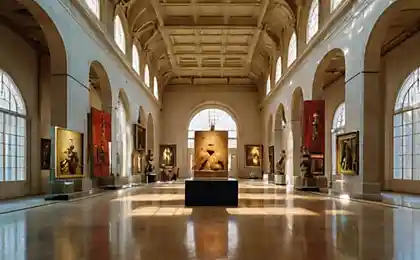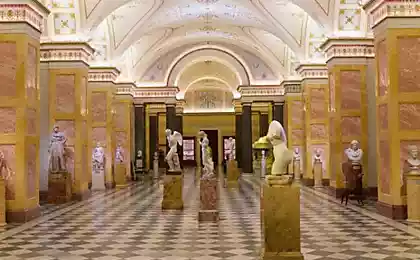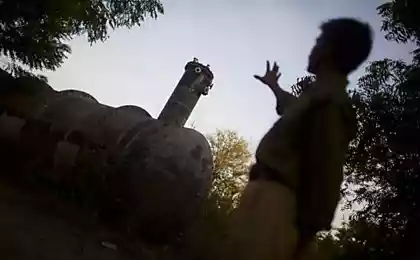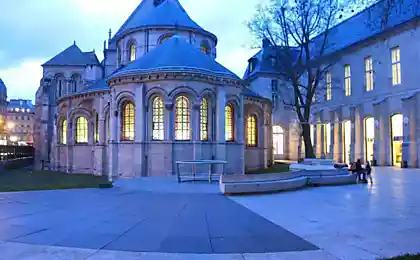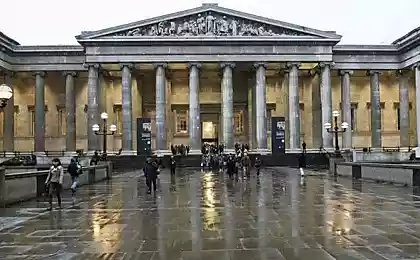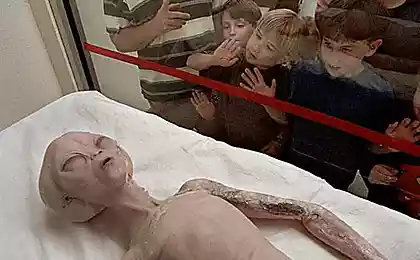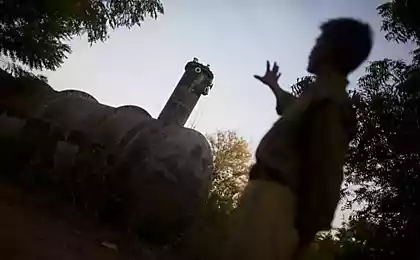1159
Aprelevka Plant Museum records.
A few days ago I announced Aprelevka records factory museum, where he had been in the New Year's holiday, arranging small retrograde holiday - and now it's time to talk about it in detail. Since the museum was very textured, then I show is divided into 3 parts, trying to stick to the chronology of historical periods.
The first part of (this) - Age of Empires, autocracy, gramophones, foppish mustache and cupids - in short, a classic: "Balls, the beautiful, the waiters, the cadets." The second - the heavy tread of the Cheka, from which all the corners scattered contra, the Iron Felix with a revolver, Comrade Stalin Rio Rita and all the gramophones. The third part - postpatefonnaya era of voluntarism and stagnation: the monumental Baltic radiograms, TV lenses, kryshesnosnye-laminar tape recorders and other hybrids Healy-Kobzon with Pugachev-Kristalinskaya. There still is horrible Perestroika c-acidic photos of girls in tight leggings chemical colors, symbols degradation recent years of the Union - is also interesting, but (perhaps) this economy, I'll try to stick to the part 3. Or go for dessert, part 4. In general, in the course of the play look.
* * *
And today we have the menu - gramophones, music boxes and other things autocratic beginning of XX century. Meet! :-)
Part 1 - The Empire
For the guide we periskop, for which he had great SPS !!!
Fot nemeryannom break can and should be, because we all grew up on vinyl?
Signboard office Aprelevka Plant (1910)
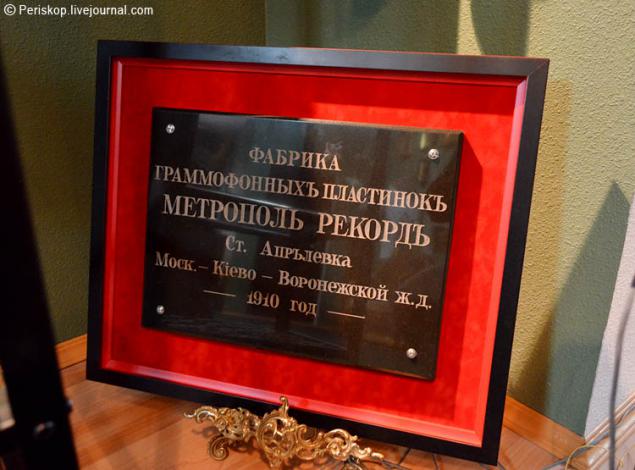
The interior of the museum, so you imagine a general disposition. Two adjacent suite of rooms, each of which is strung two elongated rooms. The first - before the revolution, the second - the Soviet. So it is quite convenient viewing. Museum of private, as the plant completely collapsed into the abyss at the most critical time of the brutal Yeltsinism (1997), when no one was not up to anything. Many of the values (which are now perceived by us as a value) then simply disappeared and were broken or gone for nothing to foreign collectors. Now everything is going to pieces - that manages to find and rescue. Thanks to the creators of the museum for the very difficult work (about it it will be the 2nd part).
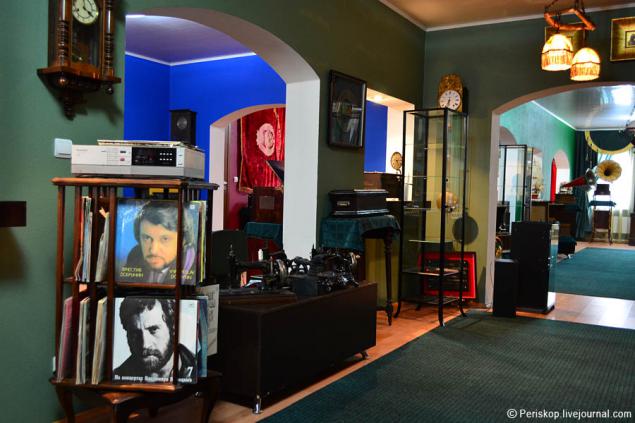
Let's start here with this kinda stuff, which, of course, is clearly older the plant (it was founded in 1910).
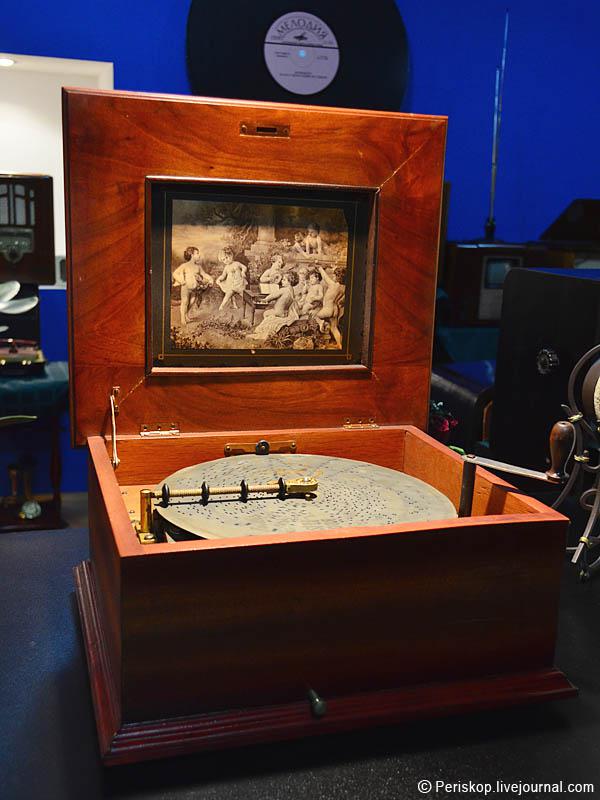
It is such a plate with holes: the plant - played. Melodic, like the xylophone, that I had as a child. We farm museum showing warden named Alexey, extremely friendly Dzyadok lean, so the music box he also started a - it is working. A pleasure to play. And the box itself is made very carefully - probably very expensive cost of such a device 120 years ago ...
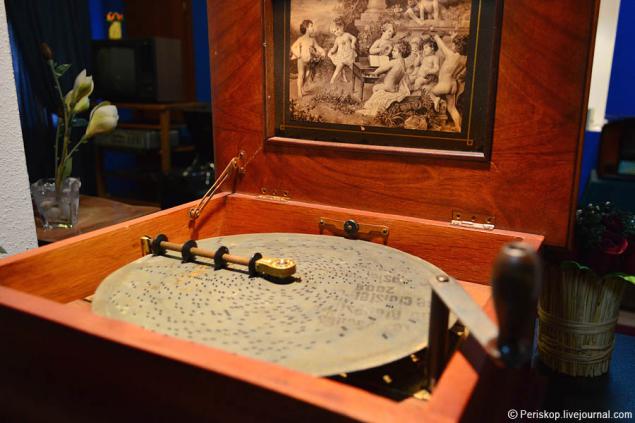
The plate is preserved and a proprietary label proivoditelya, however, polustёrtaya. Does the such a plate? Probably, but I'm not exactly sure.
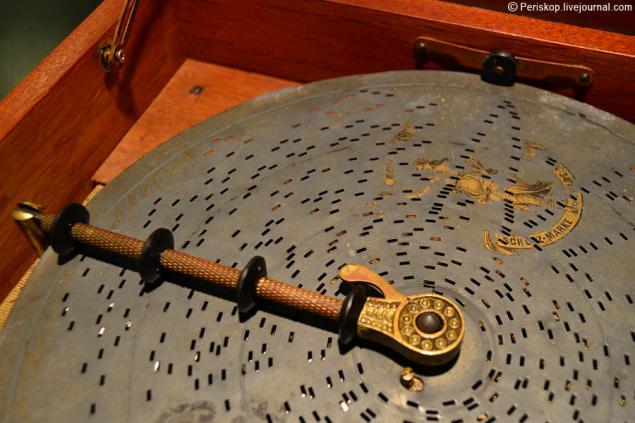
Again, everything in it is very well done and really stylish. Causes Currently respect to the master.
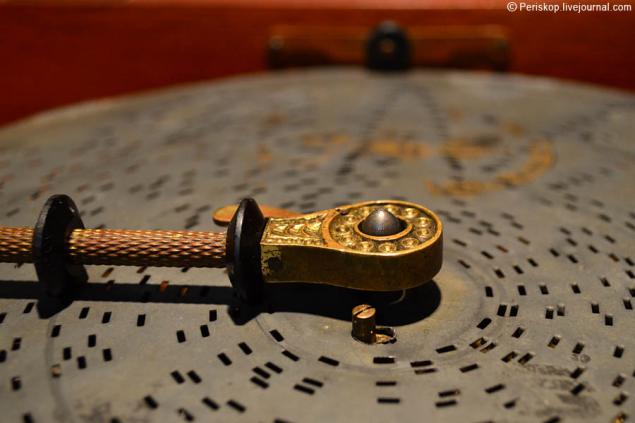
The founder of the plant, an enterprising German named Gottlieb Heinrich Carl-Mole, Russia has taken itself for the convenience of the name and patronymic Bogdan Vasilevich.
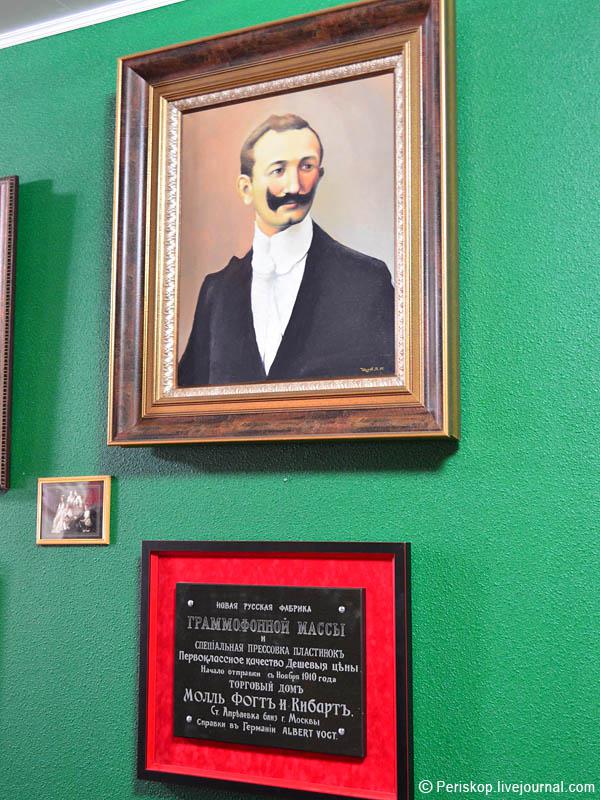
... And what gives us a sign on the building.
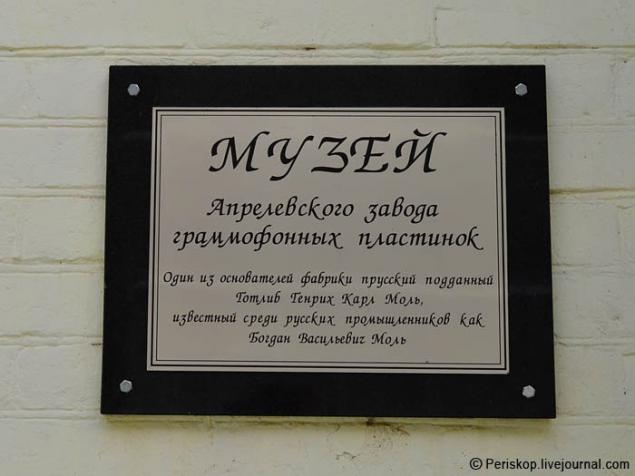
Advertising signs with the notice of the early shipments of products factory. Location location, of course, is chosen wisely: a station on the Moscow-Kiev area, next to the railroad (the perimeter of the factory and office - 50 meters from the main line, there is a driveway).
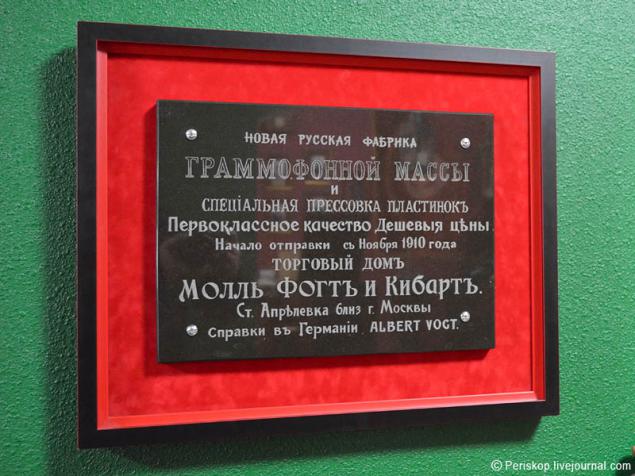
One of the surviving gramophone records, between 1911 and 1914.
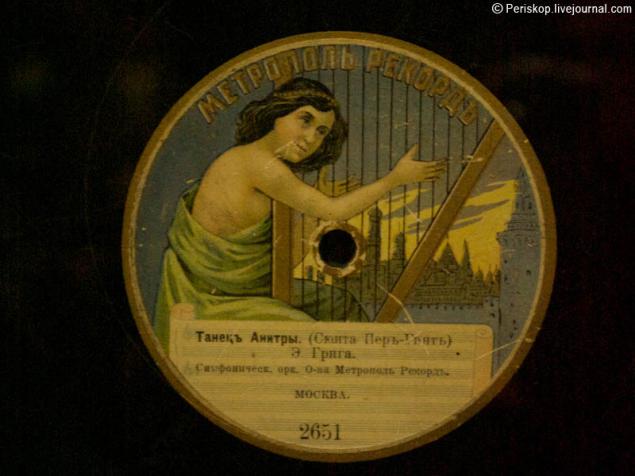
And this is - a real box "Italian" style: the creator and owner of the museum found it at a flea market and restored.
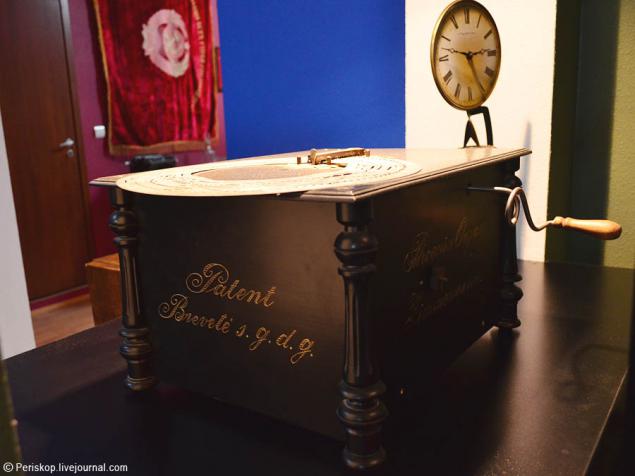
Well - now gramophones! The first of them is in a very colorful retro surroundings.

Handmade in wood, all very well-fitting: then it was a very expensive pleasure. If not mistaken, then the gramophone cost several times more expensive than a good horse.
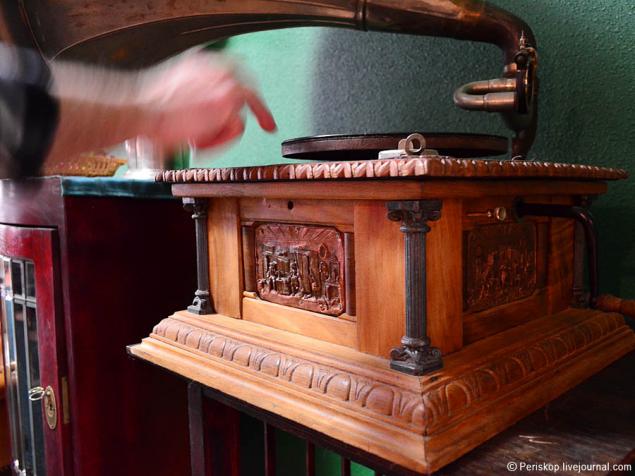
This copy - a few more later, but it stands surrounded by Gramophone, so show it here. For a more clear sound flaps open and there is music.
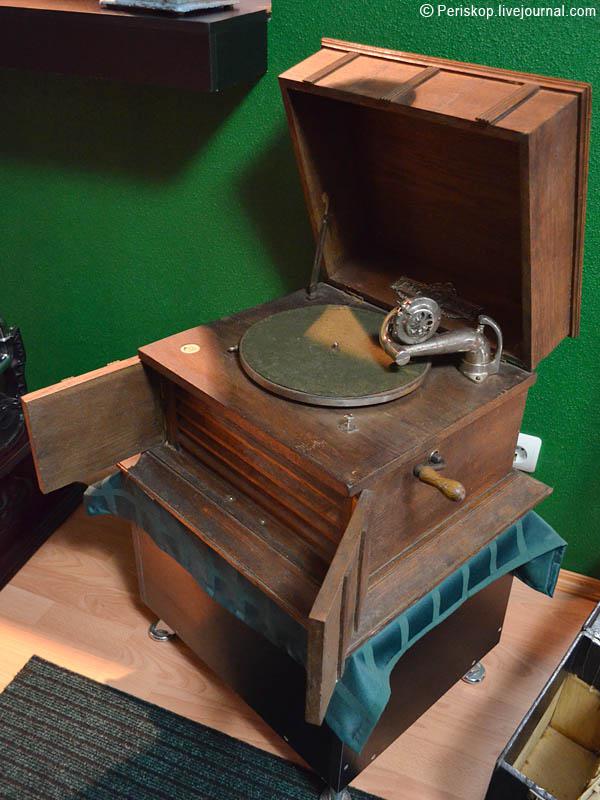
Another bright colorful gramophone with "feminine" colors. But it made in metal. It is harder and less wood.
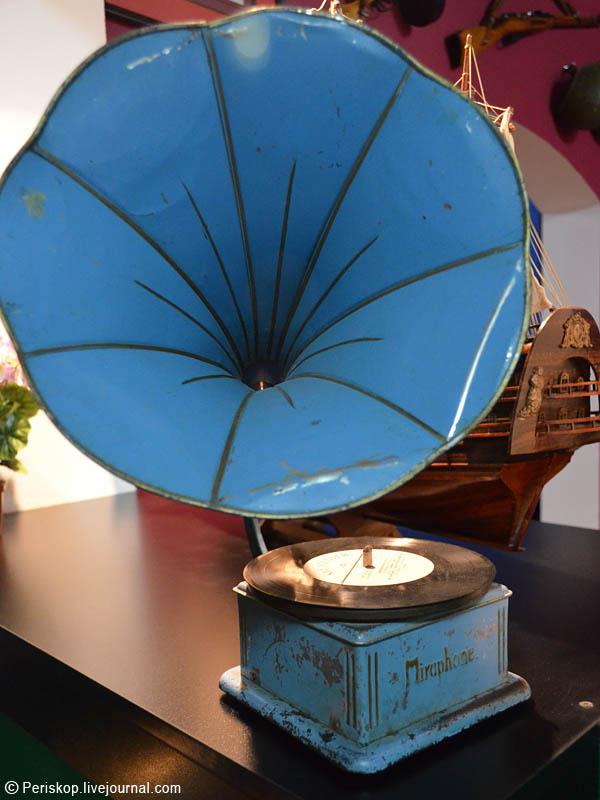
Record 1911-1914 biennium.
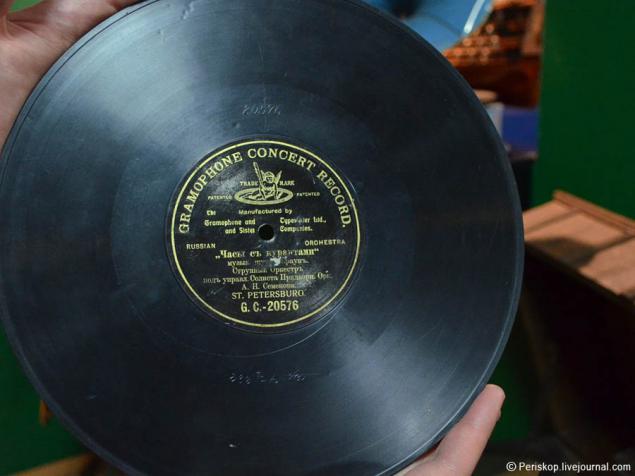
Listening to gramophone music. And we put her tireless Alexey.
Posted in [mergetime] 1326538062 [/ mergetime]
Here's the video, if you have not seen before, the gramophone sounds in the third minute:
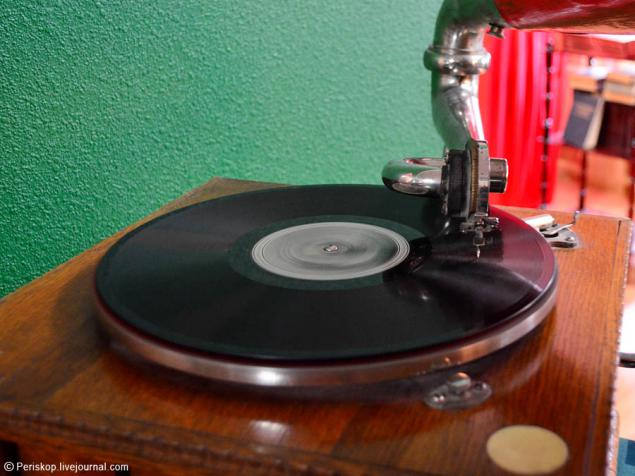
Playing this one machine.
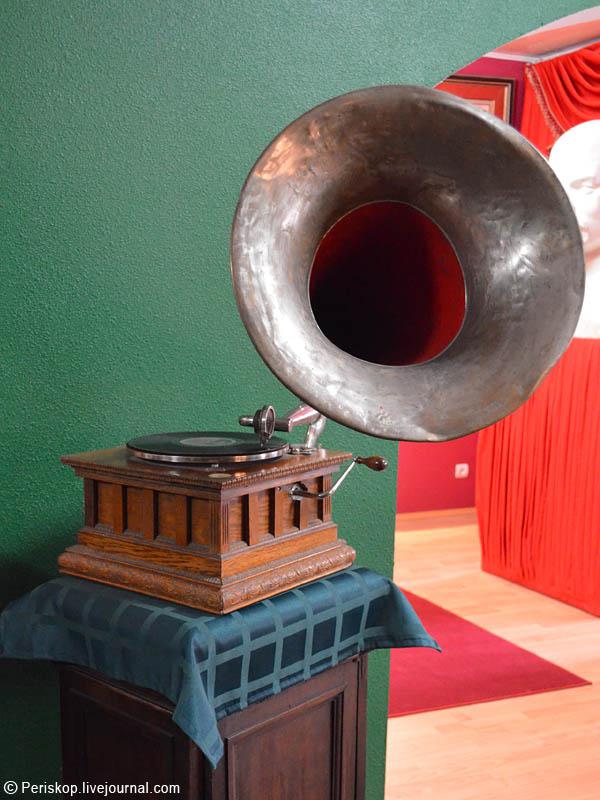
There was much surprised when I heard from the superintendent, is now producing a replica of gramophones Chinese - there are fans! Gramophone, of course, has plastikovaty view, but the fact! That would not have thought that doing now ...
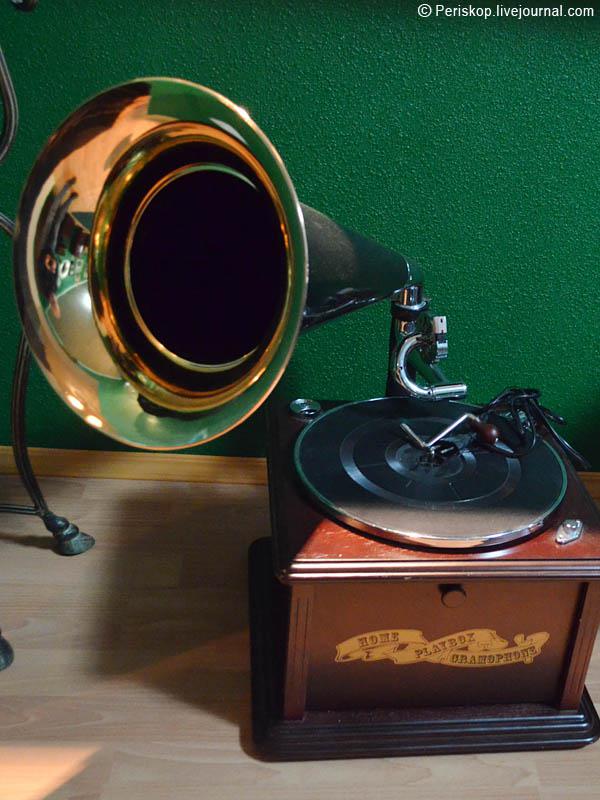
In general, I could not resist and took also a modern kitayschinu :-)
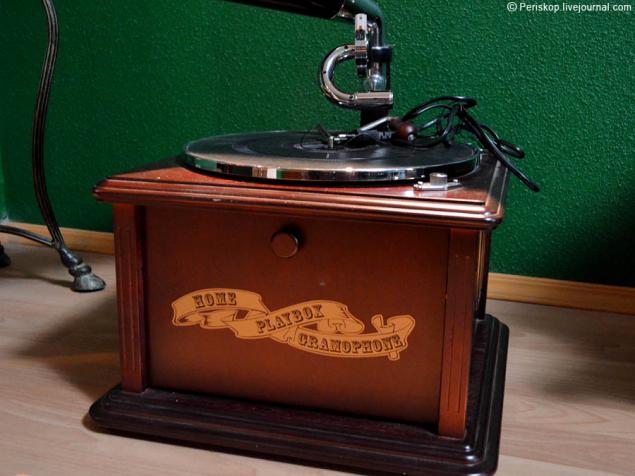
Transportable version of light, with an opening for the sound of doors
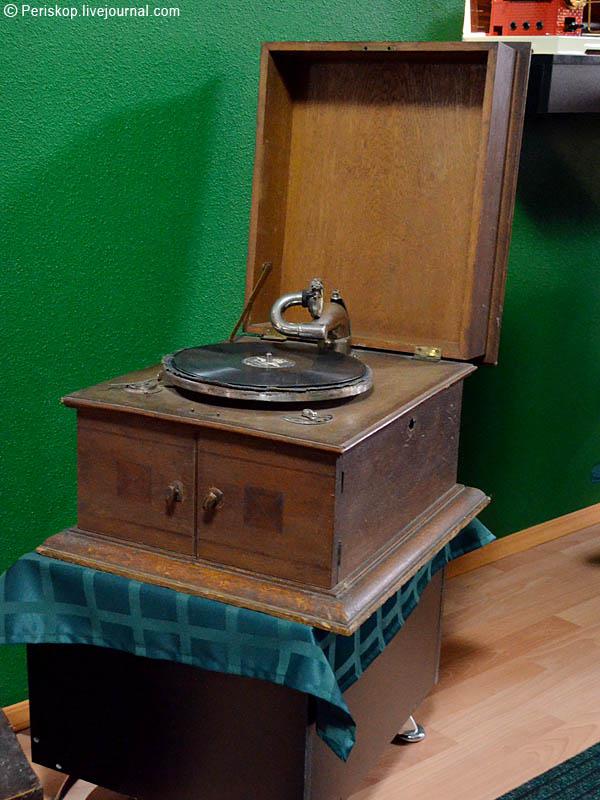
Immediately post-revolutionary-plate (approximately mid 1920).
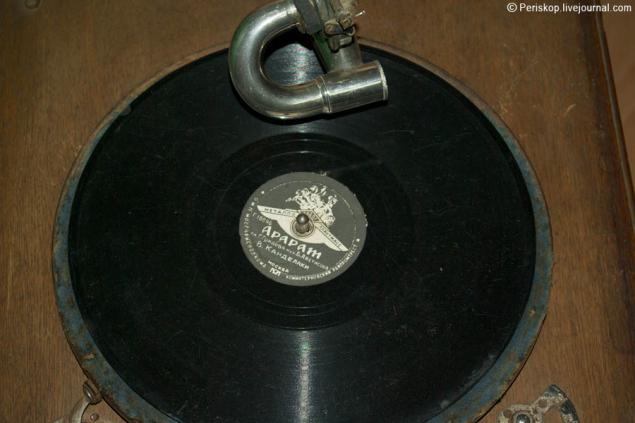
Retro interior.
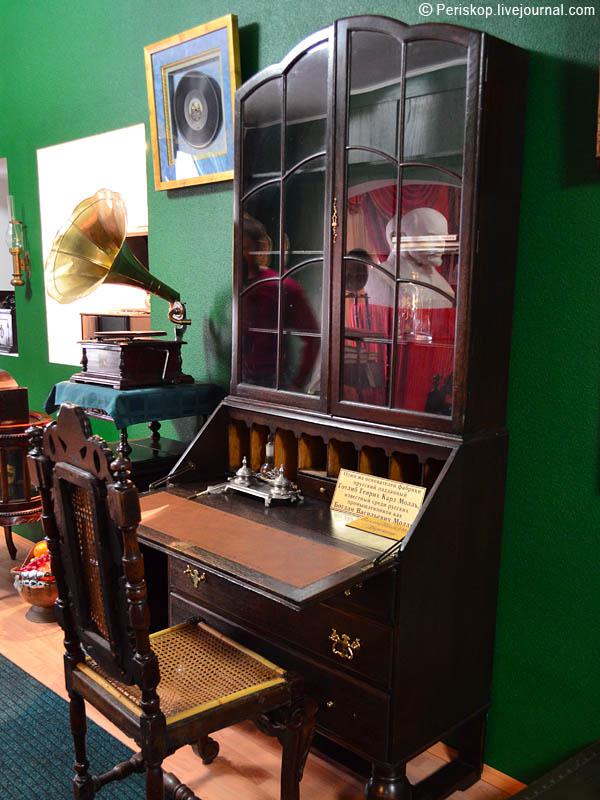
Another instance of the road and the front. And the box apparently mahogany (?).
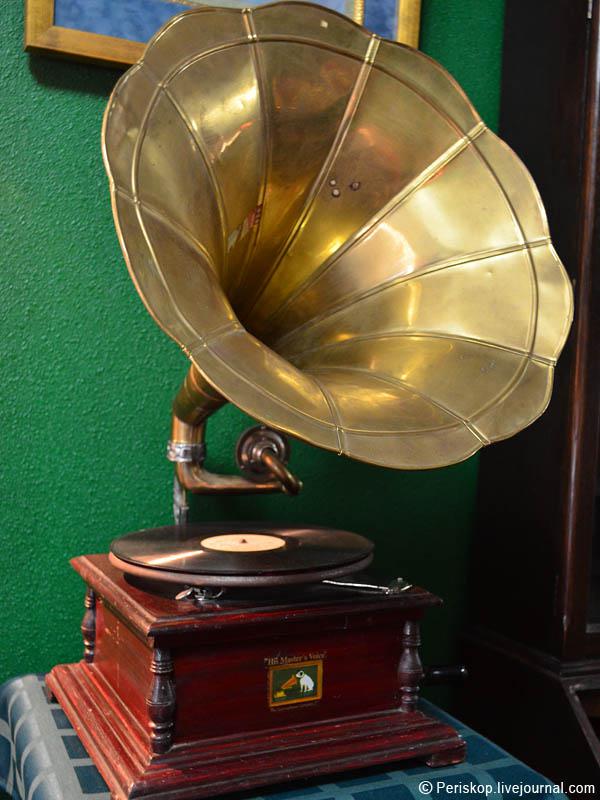
He has an interesting firm emblem manufacturer: dog spellbound listening to the sound of the pipe. By the way, I meet such an emblem is not the first time.
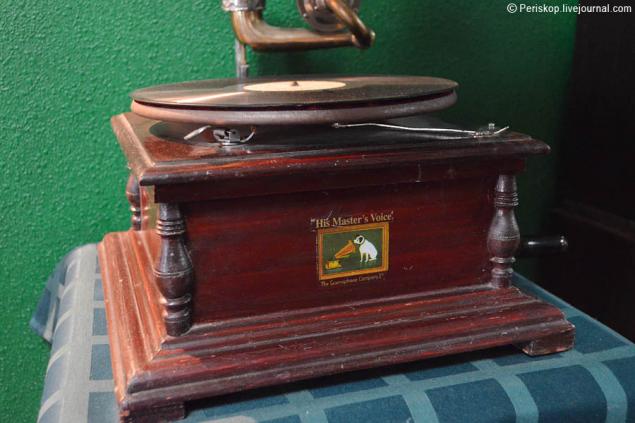
Also vip-option that looks more expensive than the previous one. And with the same dog on the face
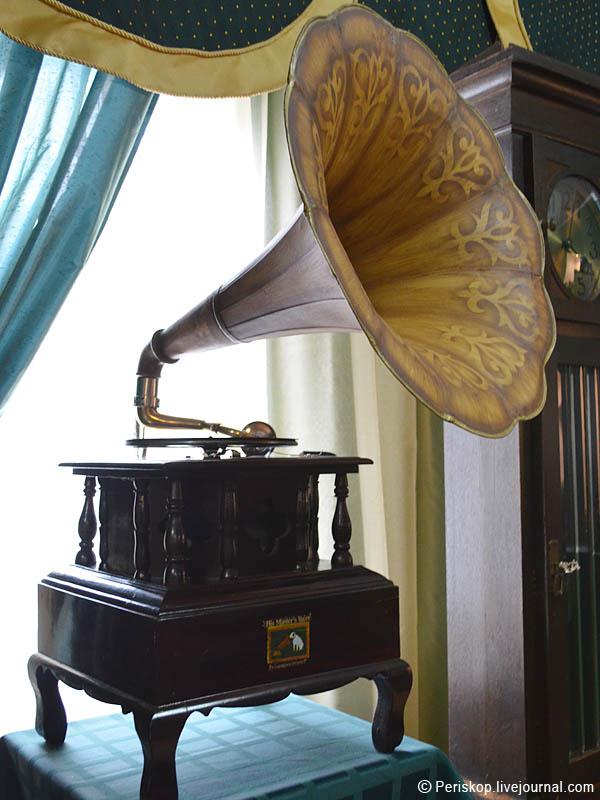
We looked into the back room, where the warden took the binder factory newspaper in 1961 I took off 5-6 rooms; however, it is a subject the following components.
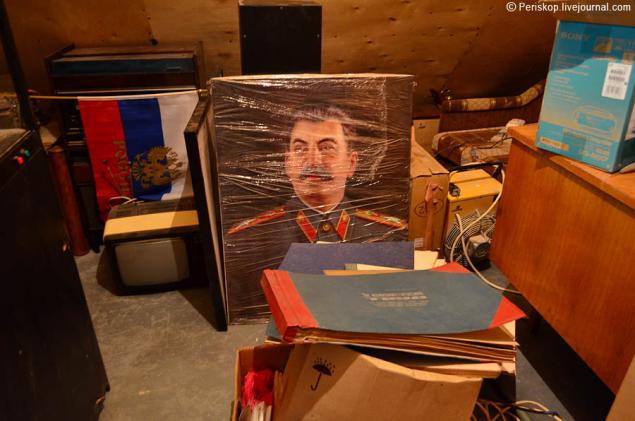
Next, go to the "Soviet" suite, that through this arch. Right - the very stylish doll, which I really looked.
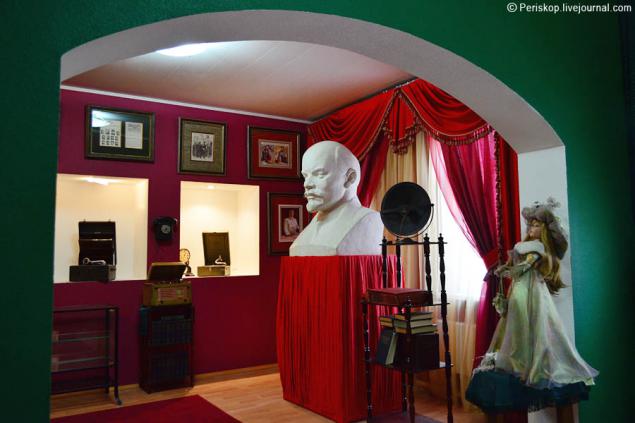
Part 2 - the USSR!
All readers - a Happy Old New Year!
I continue the story of the museum Aprelevka. If the first part of the show was at the basis of the pre-revolutionary exhibits, in this - the era of the early and middle of the USSR, about the fall of Khrushchev. So we shall proceed me in "Soviet" suite museum.
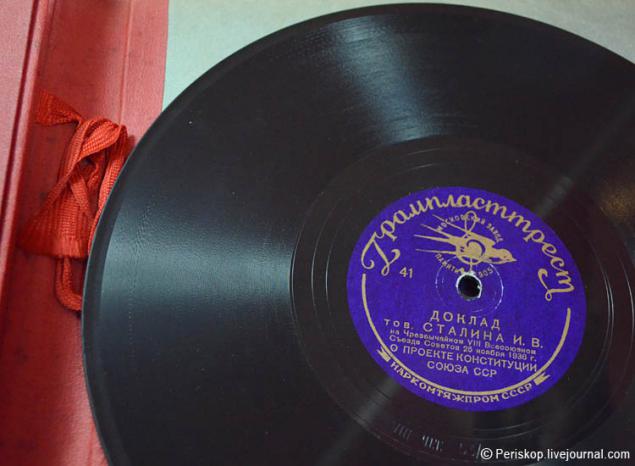
First look at the overall plan of where we are. The room is made primarily in red, complete factory Grandpa Lenin, helped out once from an abandoned auditorium.
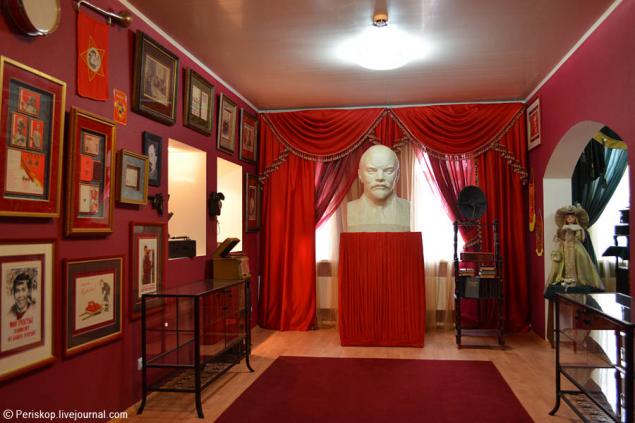
If we turn to the other side, we see far "stagnant" room with equipment and artifacts 60-80 times, which will be the next part.
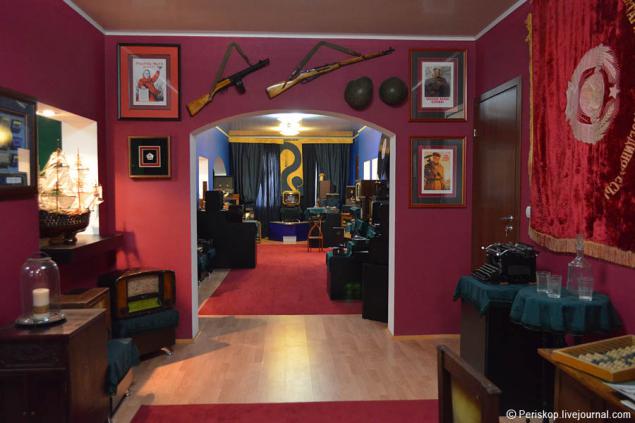
Record Utesova, presumably the second half of the 50s, the "satellite". Play our present gramophone! :-)
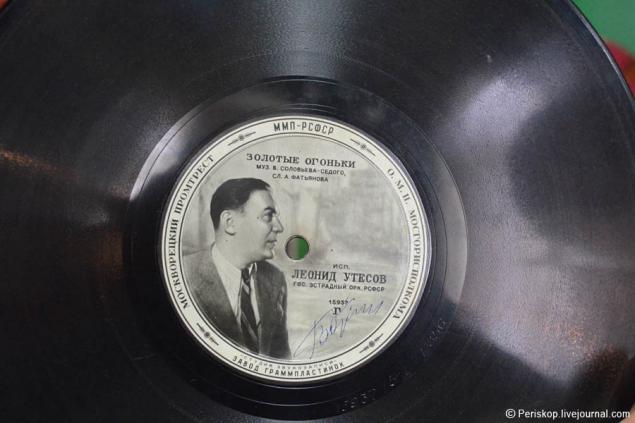
Before Ilyich - the legendary "plate", the speaker production late 1930s.
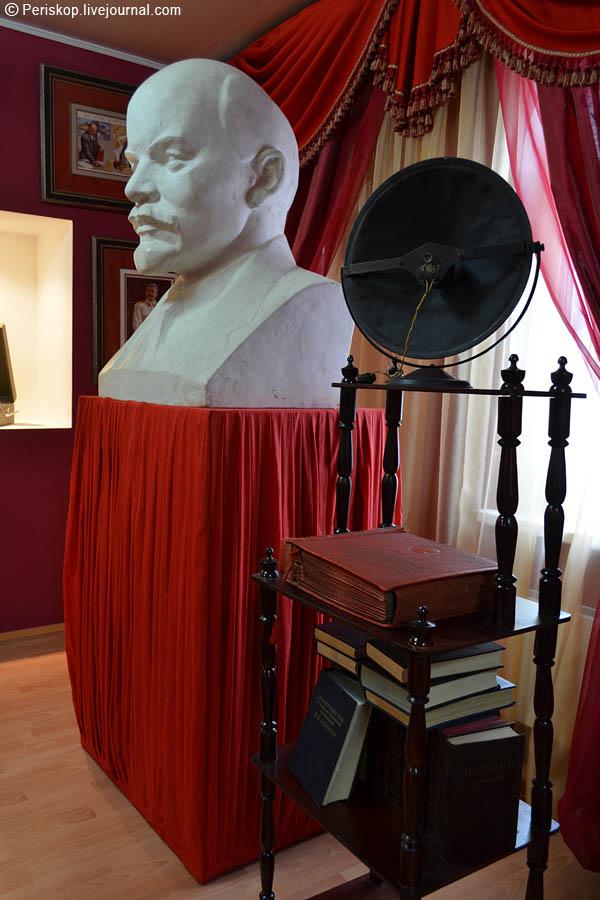
In the center of the "saucer" - a label NCC (People's Commissariat of Communications of the USSR).
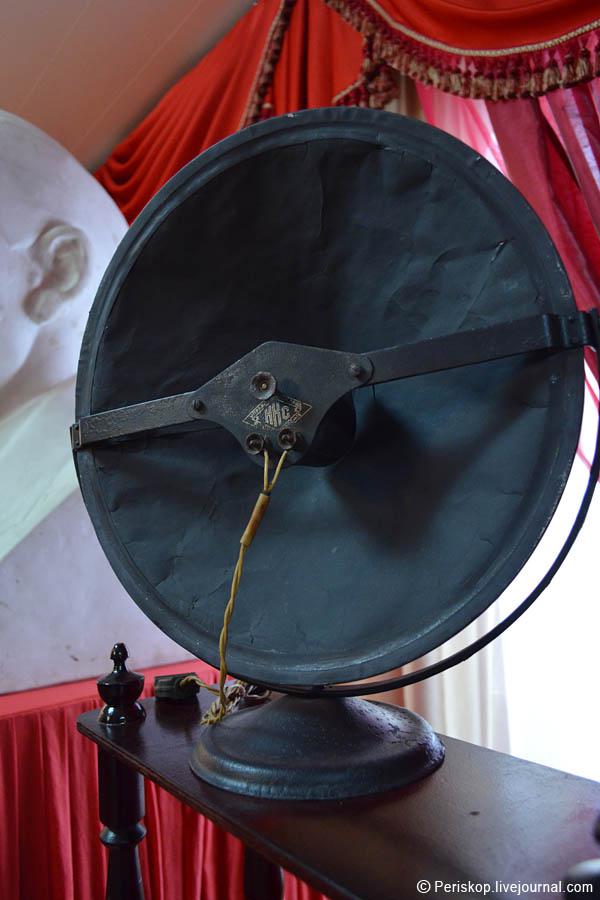
On the shelf - a multi-volume set of plates with the full version of Stalin's speech of 25 November 1936, including applause (koi occupied for the duration of more than one of a set of records, according to the caretaker).
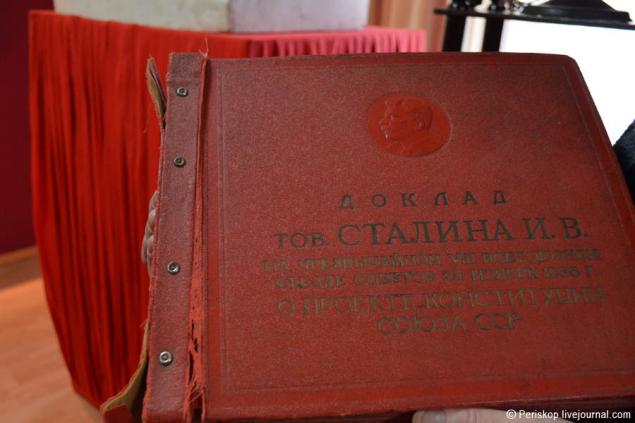
Open it ... There is more than a dozen records, set in series.

Anyway, as a private museum, and not censored from above, and reflects the style of the era quite colorfully, without rip and omissions. From there artifact saved many human rights activists have fought furiously in convulsions, and even (in the case of the peak) even went on a date to be E. Bonner.
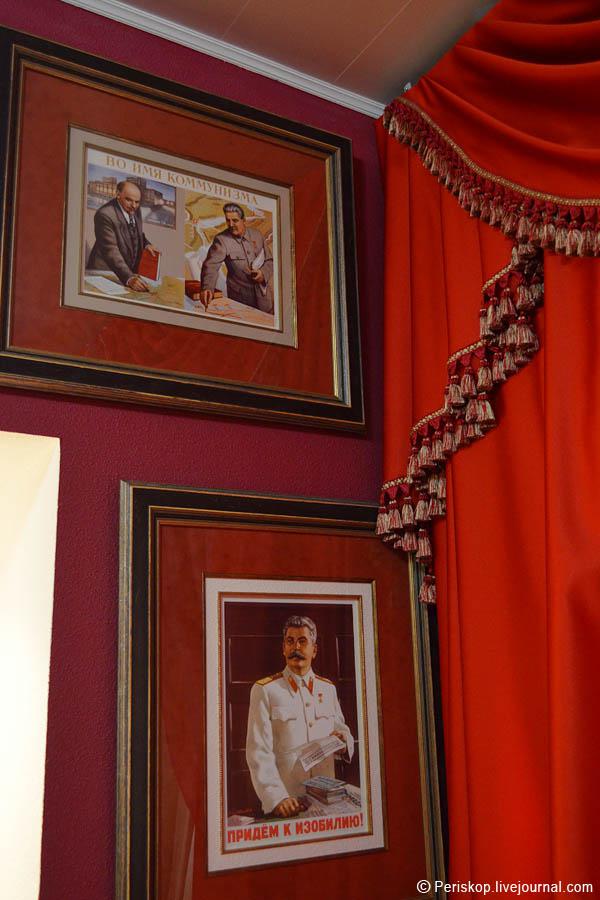
And we continue inspection. Gramophone Stalin era.
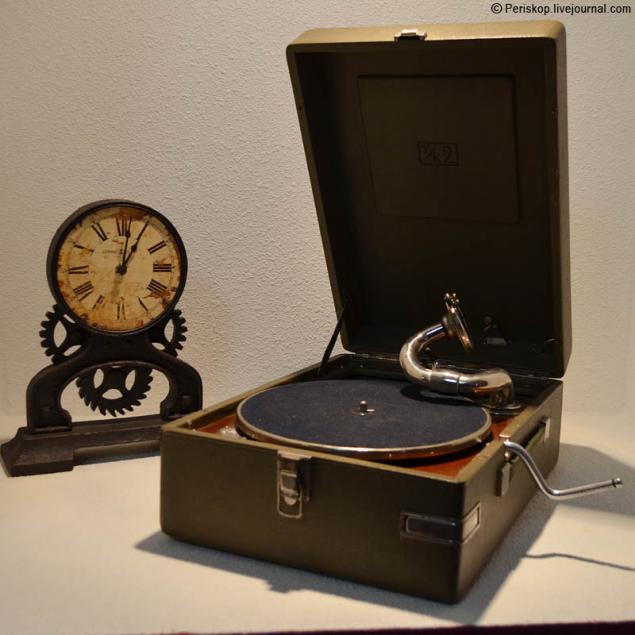
Next to it - brutal hours, which led me to the delight of his harsh shesterёnochnym design.
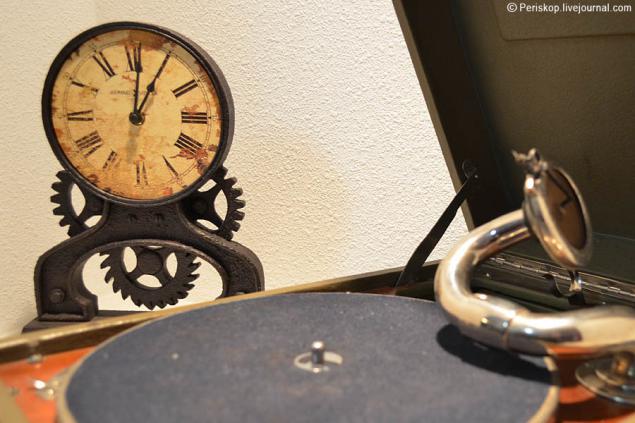
Another gramophone, more expensive and imported. Exactly how it sounds, you might hear on the video that I showed earlier.
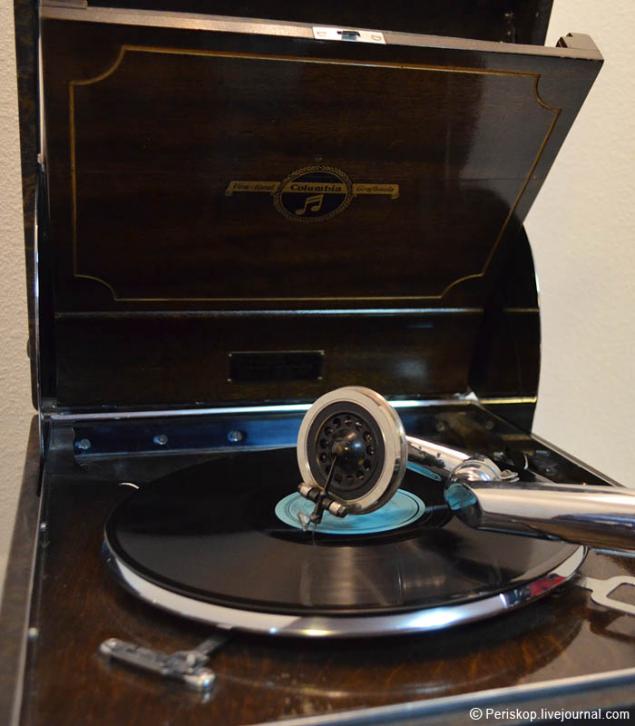
On the left - a reference matrix, which is then replicated the standard plate.
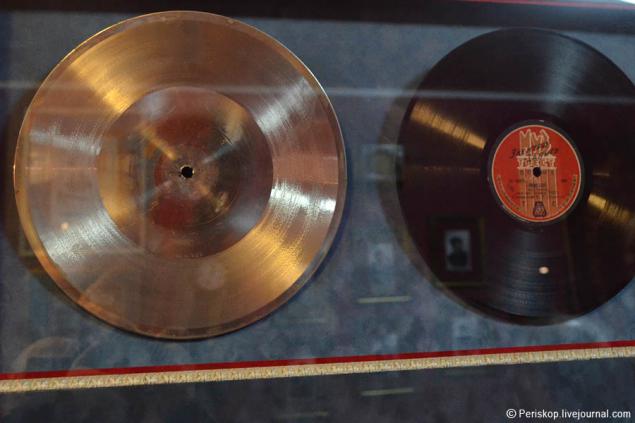
Honorary place on the wall, takes the Iron Felix, the chairman of the Cheka, below which symbolically placed the gun (the brand and the authenticity of my readers gunsmiths probably be able to determine).
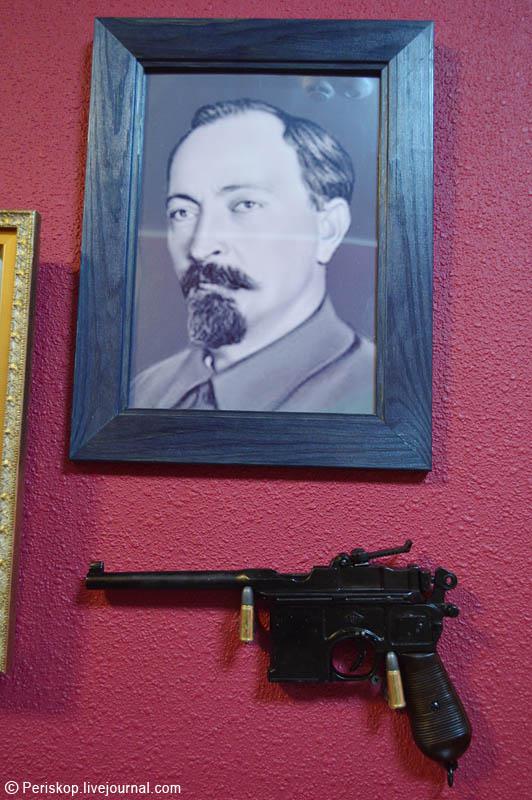
Levey and below the Felix - "privatization voucher" chubaysovaucher which made installation with black frame. As you can guess, guess, to "reform" the 90 then holds a very negative attitude.
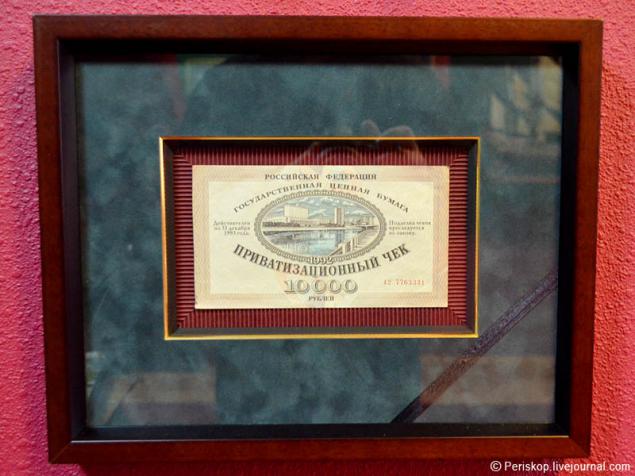
The table of the plant, covered with all sorts of stuff, from the factory saved times. Plus a list of directors of the plant, for all time of its existence.
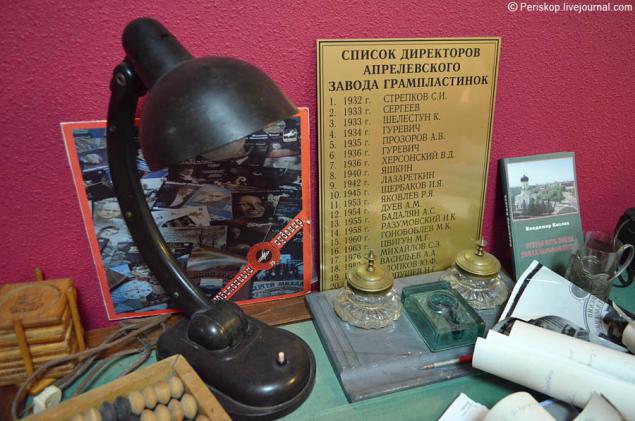
Decanter with faceted glasses, an indispensable attribute of party and union meetings. Glasses, of course, were immediately I inspected for authenticity and determine that one of them - the late-14-sided, with a stamp on the bottom "14 k.", But the other two - dishonest, made after the collapse of the Union, without direct faces. "How so? - In the museum it is imperative to have all the right glasses, not one! "- With a sigh, I chided the superintendent. He agreed: "Yes, defect ... Over time fix that."
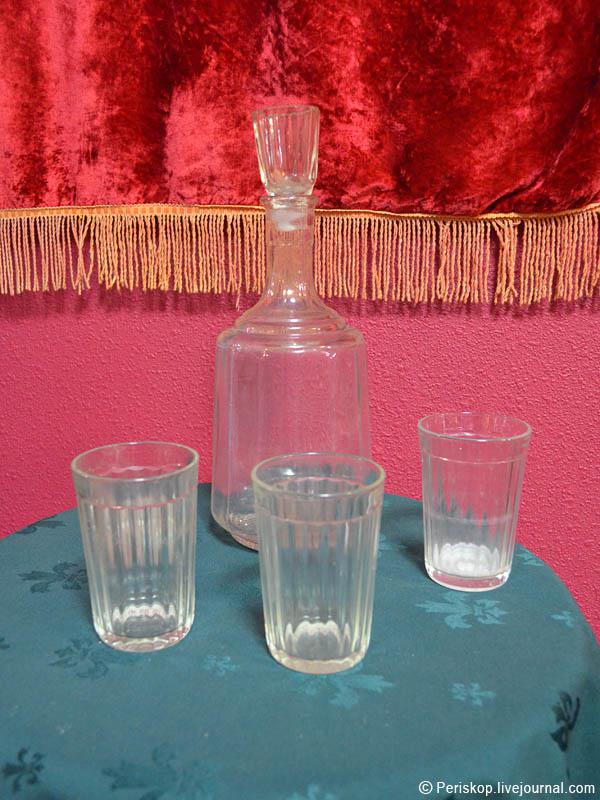
Portraits of directors of the plant.
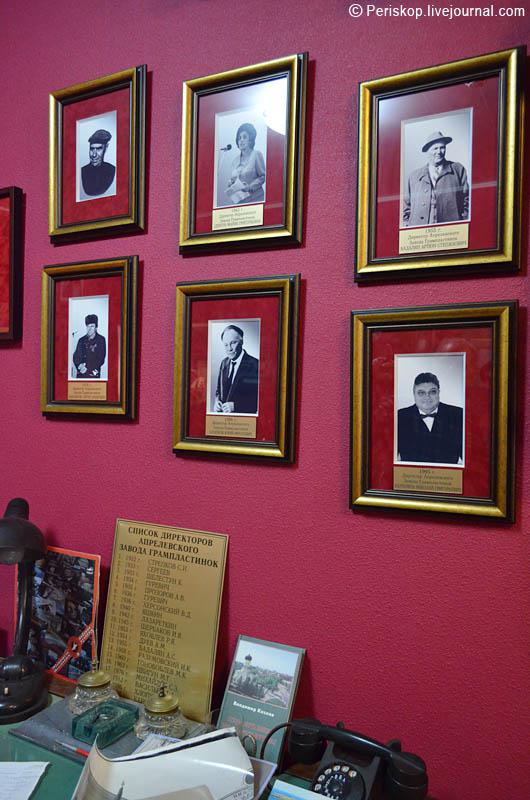
Let's see some photos. It would have been longer, I would have photographed more.
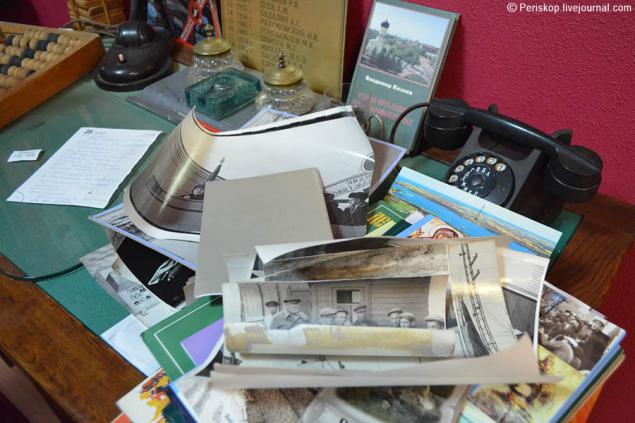
Ekaterina Furtseva (third from the left, in a headscarf), the Minister of Culture of the USSR, on the factory meeting March 16, 1971
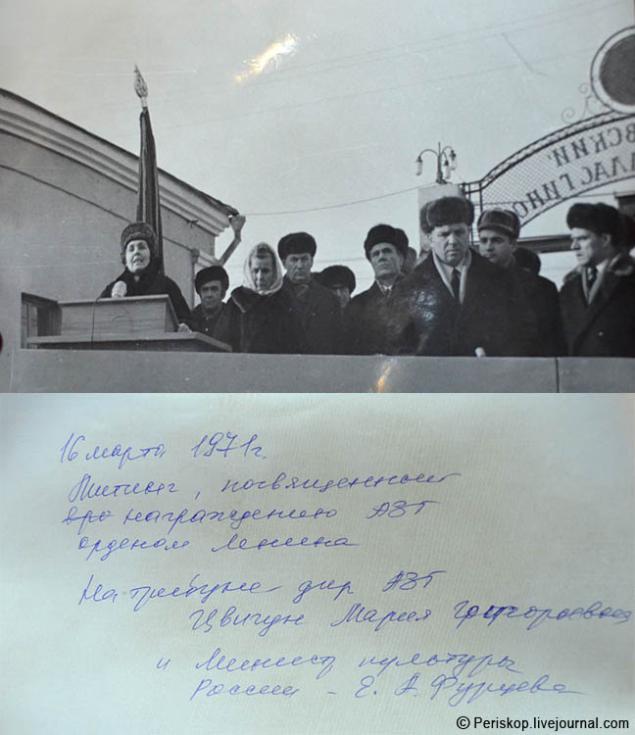
Some device for the manufacture of pulp, which is then punched out of the plate.
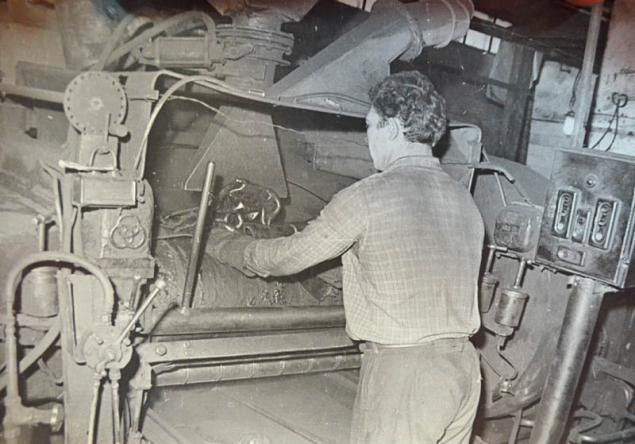
Alexey also took out from the back room of the binder factory newspapers in 1961, some of them I photographed as failed. Below - a fragment of the first bands.
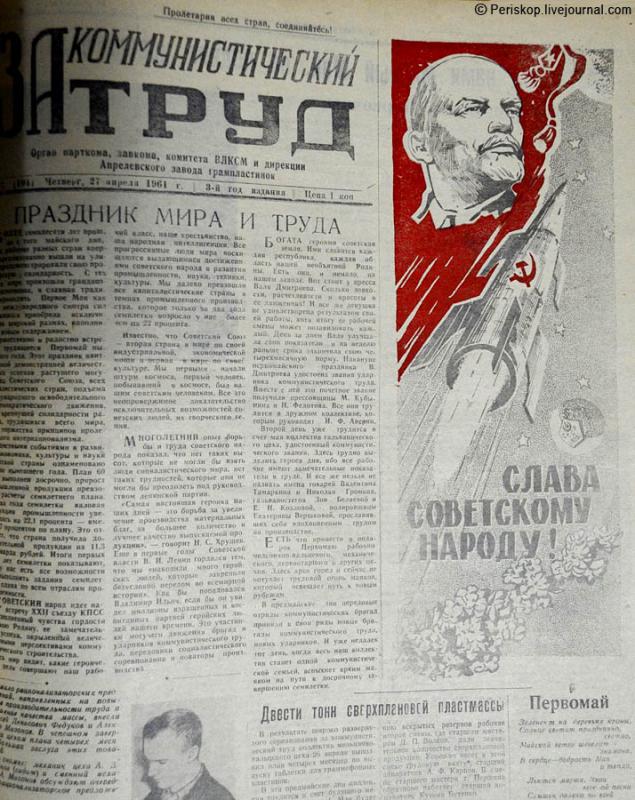
June 1, 1961
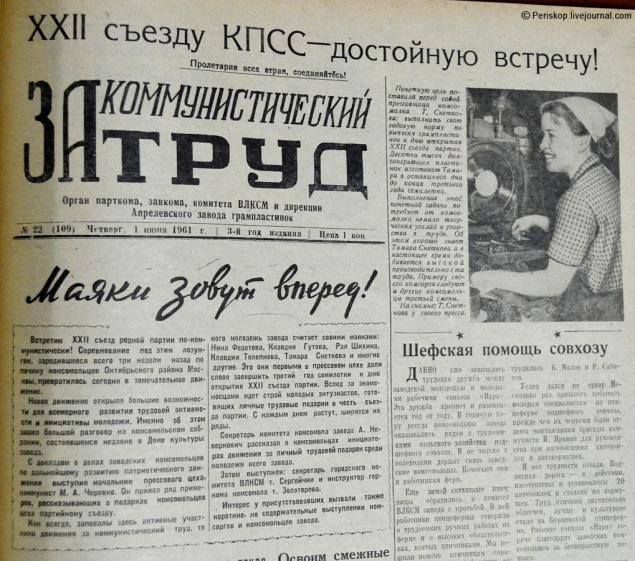
July 6, 1961
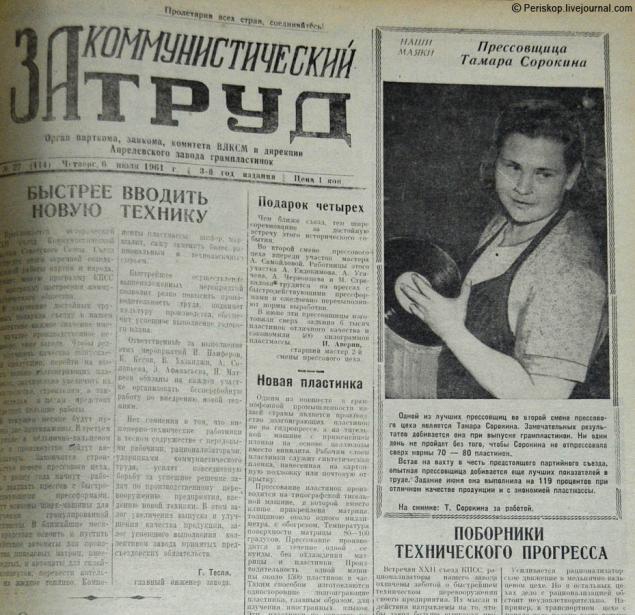
In this photo - Komsomol card museum's founder and tireless collector of his collection - Chukhontsev Boris Vladimirovich. In the world he is now the owner of a network of dental clinics, and the museum - it is a passion and a hobby. Right here, I want to express my appreciation for his enormous, but rewarding work for posterity. If not for such devotees as he - would have gone a lot, completely disappearing into the depths of ruthless time, and we would not see living evidence of our history. The museum was founded as a full-scale collection of 6 years ago, and has already collected quite a lot. And how much is stored in the back, saved from oblivion and waiting in the wings!

Cassettes that the plant tried to release after 1989, and until his death in 1997
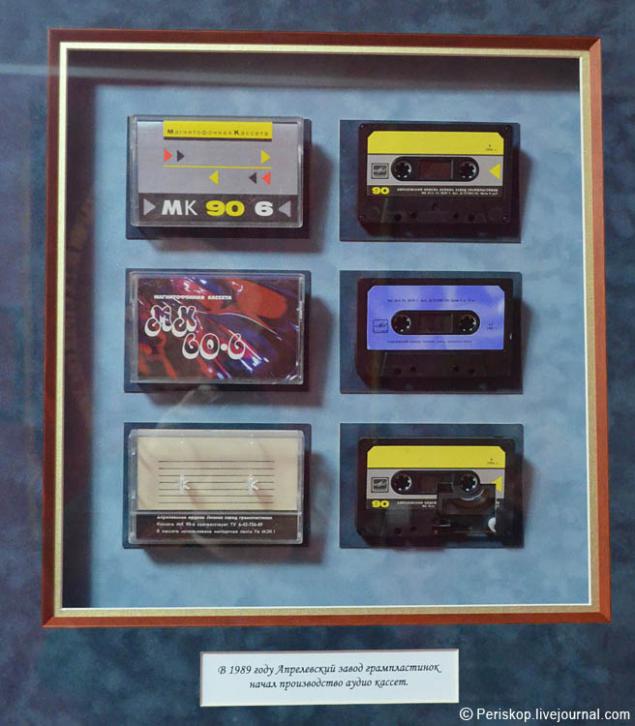
Now - a little art with "warm tube sound" over which traditionally stebetsya svezhepodrosshaya post-Soviet growth. Stamps year-I do not know, and if you know - write in the comments!
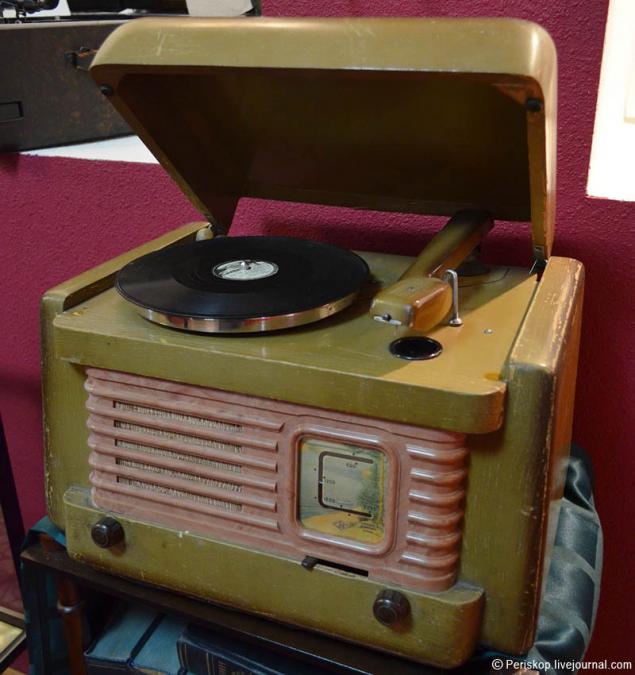
In this model, I really liked the tuning scale waves. Such a nice and cozy.
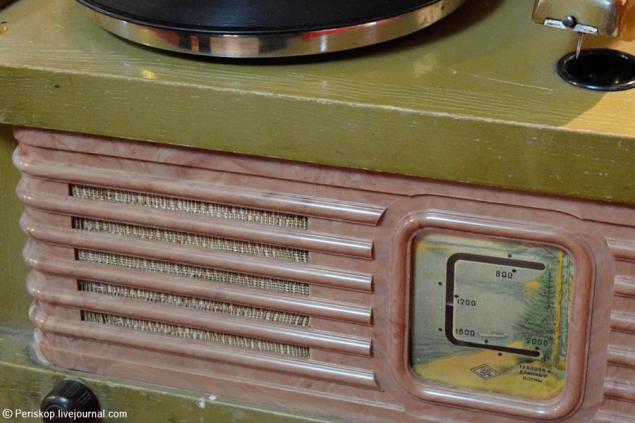
? ..
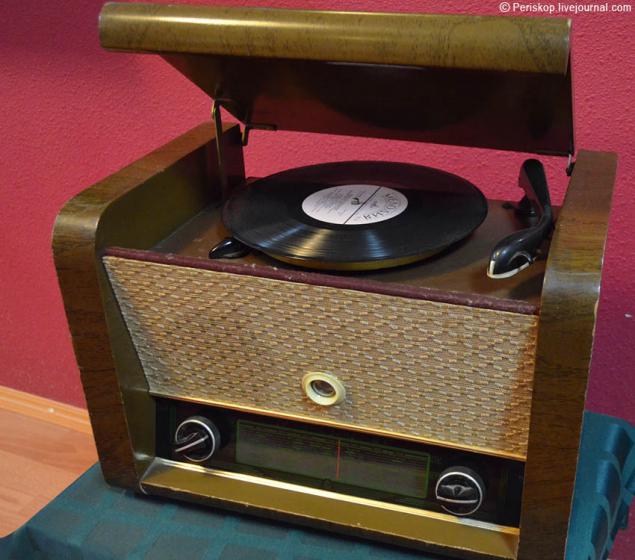
But this light, in the center glowed a soft green light, and a thin bright ray in the center of it is expanded, then narrowed following the articulation of speech. I remember very well the effect of early childhood: it was possible to sit on a chair, and a long time to follow the magical ray of light bulbs in the center.
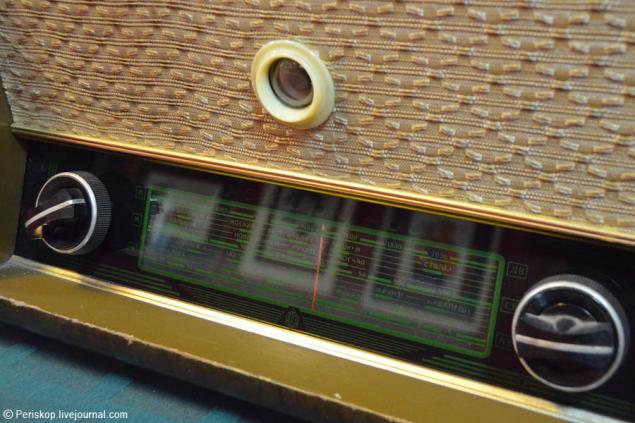
? (this is not the radiogram and a radio)
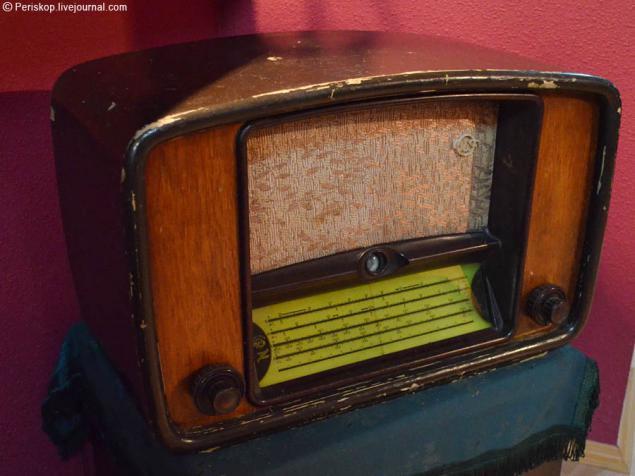
And its range. In the center, too light, a green light magic!
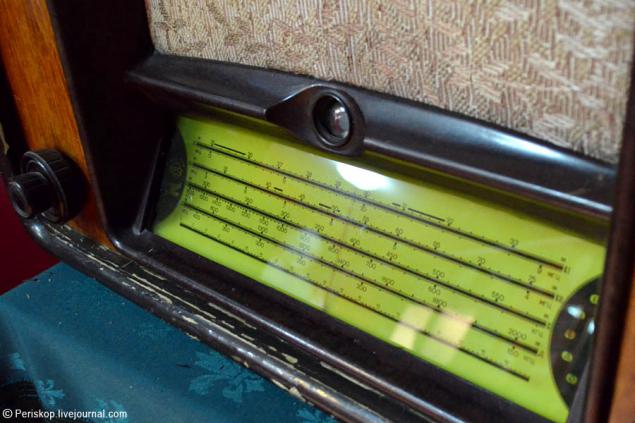
And this is busurmansky device, Telefunken.
So far, discuss, and will be continued !!!
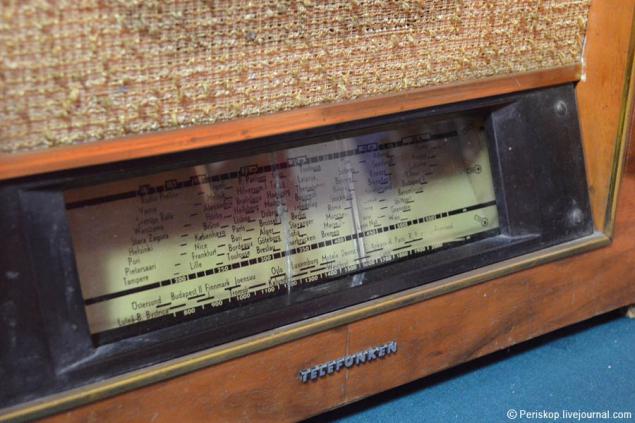
Source:
The first part of (this) - Age of Empires, autocracy, gramophones, foppish mustache and cupids - in short, a classic: "Balls, the beautiful, the waiters, the cadets." The second - the heavy tread of the Cheka, from which all the corners scattered contra, the Iron Felix with a revolver, Comrade Stalin Rio Rita and all the gramophones. The third part - postpatefonnaya era of voluntarism and stagnation: the monumental Baltic radiograms, TV lenses, kryshesnosnye-laminar tape recorders and other hybrids Healy-Kobzon with Pugachev-Kristalinskaya. There still is horrible Perestroika c-acidic photos of girls in tight leggings chemical colors, symbols degradation recent years of the Union - is also interesting, but (perhaps) this economy, I'll try to stick to the part 3. Or go for dessert, part 4. In general, in the course of the play look.
* * *
And today we have the menu - gramophones, music boxes and other things autocratic beginning of XX century. Meet! :-)
Part 1 - The Empire
For the guide we periskop, for which he had great SPS !!!
Fot nemeryannom break can and should be, because we all grew up on vinyl?
Signboard office Aprelevka Plant (1910)

The interior of the museum, so you imagine a general disposition. Two adjacent suite of rooms, each of which is strung two elongated rooms. The first - before the revolution, the second - the Soviet. So it is quite convenient viewing. Museum of private, as the plant completely collapsed into the abyss at the most critical time of the brutal Yeltsinism (1997), when no one was not up to anything. Many of the values (which are now perceived by us as a value) then simply disappeared and were broken or gone for nothing to foreign collectors. Now everything is going to pieces - that manages to find and rescue. Thanks to the creators of the museum for the very difficult work (about it it will be the 2nd part).

Let's start here with this kinda stuff, which, of course, is clearly older the plant (it was founded in 1910).

It is such a plate with holes: the plant - played. Melodic, like the xylophone, that I had as a child. We farm museum showing warden named Alexey, extremely friendly Dzyadok lean, so the music box he also started a - it is working. A pleasure to play. And the box itself is made very carefully - probably very expensive cost of such a device 120 years ago ...

The plate is preserved and a proprietary label proivoditelya, however, polustёrtaya. Does the such a plate? Probably, but I'm not exactly sure.

Again, everything in it is very well done and really stylish. Causes Currently respect to the master.

The founder of the plant, an enterprising German named Gottlieb Heinrich Carl-Mole, Russia has taken itself for the convenience of the name and patronymic Bogdan Vasilevich.

... And what gives us a sign on the building.

Advertising signs with the notice of the early shipments of products factory. Location location, of course, is chosen wisely: a station on the Moscow-Kiev area, next to the railroad (the perimeter of the factory and office - 50 meters from the main line, there is a driveway).

One of the surviving gramophone records, between 1911 and 1914.

And this is - a real box "Italian" style: the creator and owner of the museum found it at a flea market and restored.

Well - now gramophones! The first of them is in a very colorful retro surroundings.

Handmade in wood, all very well-fitting: then it was a very expensive pleasure. If not mistaken, then the gramophone cost several times more expensive than a good horse.

This copy - a few more later, but it stands surrounded by Gramophone, so show it here. For a more clear sound flaps open and there is music.

Another bright colorful gramophone with "feminine" colors. But it made in metal. It is harder and less wood.

Record 1911-1914 biennium.

Listening to gramophone music. And we put her tireless Alexey.
Posted in [mergetime] 1326538062 [/ mergetime]
Here's the video, if you have not seen before, the gramophone sounds in the third minute:

Playing this one machine.

There was much surprised when I heard from the superintendent, is now producing a replica of gramophones Chinese - there are fans! Gramophone, of course, has plastikovaty view, but the fact! That would not have thought that doing now ...

In general, I could not resist and took also a modern kitayschinu :-)

Transportable version of light, with an opening for the sound of doors

Immediately post-revolutionary-plate (approximately mid 1920).

Retro interior.

Another instance of the road and the front. And the box apparently mahogany (?).

He has an interesting firm emblem manufacturer: dog spellbound listening to the sound of the pipe. By the way, I meet such an emblem is not the first time.

Also vip-option that looks more expensive than the previous one. And with the same dog on the face

We looked into the back room, where the warden took the binder factory newspaper in 1961 I took off 5-6 rooms; however, it is a subject the following components.

Next, go to the "Soviet" suite, that through this arch. Right - the very stylish doll, which I really looked.

Part 2 - the USSR!
All readers - a Happy Old New Year!
I continue the story of the museum Aprelevka. If the first part of the show was at the basis of the pre-revolutionary exhibits, in this - the era of the early and middle of the USSR, about the fall of Khrushchev. So we shall proceed me in "Soviet" suite museum.

First look at the overall plan of where we are. The room is made primarily in red, complete factory Grandpa Lenin, helped out once from an abandoned auditorium.

If we turn to the other side, we see far "stagnant" room with equipment and artifacts 60-80 times, which will be the next part.

Record Utesova, presumably the second half of the 50s, the "satellite". Play our present gramophone! :-)

Before Ilyich - the legendary "plate", the speaker production late 1930s.

In the center of the "saucer" - a label NCC (People's Commissariat of Communications of the USSR).

On the shelf - a multi-volume set of plates with the full version of Stalin's speech of 25 November 1936, including applause (koi occupied for the duration of more than one of a set of records, according to the caretaker).

Open it ... There is more than a dozen records, set in series.

Anyway, as a private museum, and not censored from above, and reflects the style of the era quite colorfully, without rip and omissions. From there artifact saved many human rights activists have fought furiously in convulsions, and even (in the case of the peak) even went on a date to be E. Bonner.


And we continue inspection. Gramophone Stalin era.

Next to it - brutal hours, which led me to the delight of his harsh shesterёnochnym design.

Another gramophone, more expensive and imported. Exactly how it sounds, you might hear on the video that I showed earlier.

On the left - a reference matrix, which is then replicated the standard plate.

Honorary place on the wall, takes the Iron Felix, the chairman of the Cheka, below which symbolically placed the gun (the brand and the authenticity of my readers gunsmiths probably be able to determine).

Levey and below the Felix - "privatization voucher" chubaysovaucher which made installation with black frame. As you can guess, guess, to "reform" the 90 then holds a very negative attitude.

The table of the plant, covered with all sorts of stuff, from the factory saved times. Plus a list of directors of the plant, for all time of its existence.

Decanter with faceted glasses, an indispensable attribute of party and union meetings. Glasses, of course, were immediately I inspected for authenticity and determine that one of them - the late-14-sided, with a stamp on the bottom "14 k.", But the other two - dishonest, made after the collapse of the Union, without direct faces. "How so? - In the museum it is imperative to have all the right glasses, not one! "- With a sigh, I chided the superintendent. He agreed: "Yes, defect ... Over time fix that."

Portraits of directors of the plant.

Let's see some photos. It would have been longer, I would have photographed more.

Ekaterina Furtseva (third from the left, in a headscarf), the Minister of Culture of the USSR, on the factory meeting March 16, 1971

Some device for the manufacture of pulp, which is then punched out of the plate.

Alexey also took out from the back room of the binder factory newspapers in 1961, some of them I photographed as failed. Below - a fragment of the first bands.

June 1, 1961

July 6, 1961

In this photo - Komsomol card museum's founder and tireless collector of his collection - Chukhontsev Boris Vladimirovich. In the world he is now the owner of a network of dental clinics, and the museum - it is a passion and a hobby. Right here, I want to express my appreciation for his enormous, but rewarding work for posterity. If not for such devotees as he - would have gone a lot, completely disappearing into the depths of ruthless time, and we would not see living evidence of our history. The museum was founded as a full-scale collection of 6 years ago, and has already collected quite a lot. And how much is stored in the back, saved from oblivion and waiting in the wings!

Cassettes that the plant tried to release after 1989, and until his death in 1997

Now - a little art with "warm tube sound" over which traditionally stebetsya svezhepodrosshaya post-Soviet growth. Stamps year-I do not know, and if you know - write in the comments!

In this model, I really liked the tuning scale waves. Such a nice and cozy.

? ..

But this light, in the center glowed a soft green light, and a thin bright ray in the center of it is expanded, then narrowed following the articulation of speech. I remember very well the effect of early childhood: it was possible to sit on a chair, and a long time to follow the magical ray of light bulbs in the center.

? (this is not the radiogram and a radio)

And its range. In the center, too light, a green light magic!

And this is busurmansky device, Telefunken.
So far, discuss, and will be continued !!!

Source:




